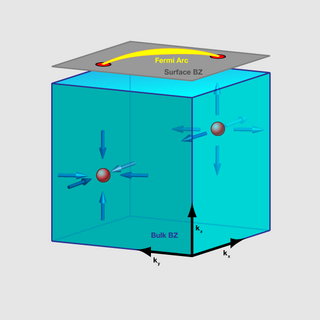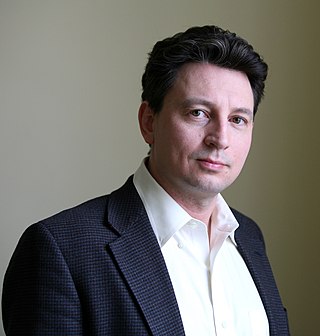
In physics, polaritons are quasiparticles resulting from strong coupling of electromagnetic waves with an electric or magnetic dipole-carrying excitation. They are an expression of the common quantum phenomenon known as level repulsion, also known as the avoided crossing principle. Polaritons describe the crossing of the dispersion of light with any interacting resonance. To this extent polaritons can also be thought of as the new normal modes of a given material or structure arising from the strong coupling of the bare modes, which are the photon and the dipolar oscillation. The polariton is a bosonic quasiparticle, and should not be confused with the polaron, which is an electron plus an attached phonon cloud.
Phaedon Avouris is a Greek chemical physicist and materials scientist. He is an IBM Fellow and was formerly the group leader for Nanometer Scale Science and Technology at the Thomas J. Watson Research Center in Yorktown Heights, New York.
In particle physics, a relativistic particle is an elementary particle, of which the kinetic energy is comparable to or exceeds the rest-mass energy given by Einstein's relation, , or specifically, of which the velocity is comparable to the speed of light .
Polariton superfluid is predicted to be a state of the exciton-polaritons system that combines the characteristics of lasers with those of excellent electrical conductors. Researchers look for this state in a solid state optical microcavity coupled with quantum well excitons. The idea is to create an ensemble of particles known as exciton-polaritons and trap them. Wave behavior in this state results in a light beam similar to that from a laser but possibly more energy efficient.
Alexander Rudolf Hamilton is with the School of Physics at the University of New South Wales (UNSW). He is notable in the area of experimental condensed matter physics, particularly semiconductor nanofabrication and the study of quantum effects in nanometer scale electronic devices at ultra-low temperatures.
In physics the Exciton–polariton is a type of polariton; a hybrid light and matter quasiparticle arising from the strong coupling of the electromagnetic dipolar oscillations of excitons and photons. Because light excitations are observed classically as photons, which are massless particles, they do not therefore have mass, like a physical particle. This property makes them a quasiparticle.
Allan H. MacDonald is a theoretical condensed matter physicist and the Sid W. Richardson Foundation Regents Chair Professor of Physics at The University of Texas at Austin. He was born in Antigonish, Nova Scotia, Canada, and attended local schools completing a B.S. at St. Francis Xavier University in 1973. He completed his Ph.D.in physics at The University of Toronto in 1978, working with S.H. Vosko on relativistic generalizations of density functional theory, and on the application of density functional theory to magnetism in metals.
The Centre for Advanced 2D Materials (CA2DM), at the National University of Singapore (NUS), is the first centre in Asia dedicated to graphene research. The Centre was established under the scientific advice of two Nobel Laureates in physics – Prof Andre Geim and Prof Konstantin Novoselov - who won the 2010 Nobel Prize in Physics for their discovery of graphene. It was created for the conception, characterization, theoretical modeling, and development of transformative technologies based on two-dimensional crystals, such as graphene. In 2019, Prof Konstantin Novoselov moved to Singapore and joined NUS as Distinguished Professor of Materials Science and Engineering.
Stanene is a topological insulator, theoretically predicted by Prof. Shoucheng Zhang's group at Stanford, which may display dissipationless currents at its edges near room temperature. It is composed of tin atoms arranged in a single layer, in a manner similar to graphene. Stanene got its name by combining stannum with the suffix -ene used by graphene. Research is ongoing in Germany and China, as well as at laboratories at Stanford and UCLA.

Weyl fermions are massless chiral fermions embodying the mathematical concept of a Weyl spinor. Weyl spinors in turn play an important role in quantum field theory and the Standard Model, where they are a building block for fermions in quantum field theory. Weyl spinors are a solution to the Dirac equation derived by Hermann Weyl, called the Weyl equation. For example, one-half of a charged Dirac fermion of a definite chirality is a Weyl fermion.

Xue Qikun is a Chinese physicist. He is a professor of Tsinghua University, Beijing. He has done much work in Condensed Matter Physics, especially on superconductors and topological insulators. In 2013, Xue was the first to achieve the quantum anomalous Hall effect (QAHE), an unusual orderly motion of electrons in a conductor, in his laboratory at Tsinghua University. Xue is a member of the Chinese Academy of Sciences, vice president for research of Tsinghua University, and director of State Key Lab of Quantum Physics. In 2016, he was one of the first recipients of the new Chinese Future Science Award for experimental discovery of high-temperature superconductivity at material interfaces and the QAHE. This award has been described as "China's Nobel Prize".

A Dirac cone is an electronic structure to describe electrons with photon-like relativistic effect in two-dimensional materials systems. Scientists believe that Dirac cones can provide a path to the next-generation computer chips, quantum computing, superconductors and desktop relativistic mechanics and technology.
Elisa Molinari is an Italian physicist from the University of Modena and CNR, Italy. She has been primarily interested in computational materials science and nanotechnologies, and she has been particularly active in the theory of fundamental properties of low-dimensional structures, in the simulation of nanodevices, in the development of related computational methods. She also has a continuing interest in scientific imaging and communication.
Quantum materials is an umbrella term in condensed matter physics that encompasses all materials whose essential properties cannot be described in terms of semiclassical particles and low-level quantum mechanics. These are materials that present strong electronic correlations or some type of electronic order, such as superconducting or magnetic orders, or materials whose electronic properties are linked to non-generic quantum effects – topological insulators, Dirac electron systems such as graphene, as well as systems whose collective properties are governed by genuinely quantum behavior, such as ultra-cold atoms, cold excitons, polaritons, and so forth. On the microscopic level, four fundamental degrees of freedom – that of charge, spin, orbit and lattice – become intertwined, resulting in complex electronic states; the concept of emergence is a common thread in the study of quantum materials.
Michael Fuhrer is a US/Australian physicist recognised internationally as a pioneer in atomically-thin (two-dimensional) materials, including graphene and novel topological materials, with expertise in fabrication and characterisation of their electronic and optical properties.
Xiaolin Wang is a Chinese-Australian scientist recognised for his work in advanced materials synthesis and characterisation and spintronics. He is director of the Institute for Superconducting and Electronic Materials, University of Wollongong. Wang is a University of Wollongong senior professor, and an Australian Research Council future fellow.

Matthew Davis is a New Zealand/Australian physicist, and is Head of Physics at the University of Queensland, Australia. He is known for his work on the dynamics of vortices and superfluidity in Bose–Einstein condensates, particularly at finite temperatures
Professor Lan Wang is a Chinese-Australian material scientist known for expertise in materials synthesis and advanced materials characterisation.

Jared Cole is an Australian theoretical physicist specialising in quantum physics and decoherence theory and its application to solid-state systems. He specialises in using mathematical and computational models to describe the design and operation of quantum computing and quantum electronic devices.

Victor Galitski is an American physicist, a theorist in the areas of condensed matter physics and quantum physics.







